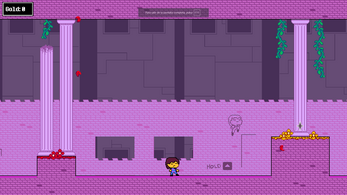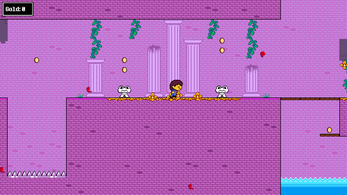PLATFORMTALE
A very short demo for a platformer based on "Undertale", by Toby Fox. Made in Construct 3, for a college project.
| Status | Prototype |
| Platforms | HTML5 |
| Rating | Rated 2.5 out of 5 stars (2 total ratings) |
| Author | Eliseo Arabel |
| Genre | Platformer |
| Made with | Construct |
| Tags | 2D, Fangame, Pixel Art, Singleplayer, Undertale |



Comments
Log in with itch.io to leave a comment.
I have a fink skill isue with this game
I love it! IT LOOK SO GOOD *chefs kiss*
Quite a cool game, I've been looking for something similar for a long time!
I can say that if it had coyote time and input buffering, it would be even better. And also the moment when you have to run away from Wimsun is too difficult, you can make it a little slower.
Otherwise, everything is fine, and I liked this game! I also really liked the graphics and this mix of styles between the original Undertale and Pizza Tower.
This is quite a fun project. I'll say, however, that integrating Coyote Time and Input Buffering goes a long way in making a platformer feel nice to play. Here's a refresher on what these mechanics are, in case you forgot.
Coyote Time: This mechanic is inspired by Looney Tunes' Wile E. Coyote and the Road Runner sketches where Wile would, upon walking off a cliff, float in mid air for comedic effect. In practice, Coyote Time serves as a mechanism to aid in a player's ability to perform precision jumps. By allowing a jump input to be successfully performed while the player is in mid-air during the first few frames after leaving a platform, the player would, theoretically, jump on nothing. In practice, this mechanic adds leeway to any jump that may be otherwise tight, sometimes having a success window of only a handful of frames.
Input Buffering: In platforming games it makes natural sense for the player to only be able to jump when landing on solid ground. To achieve this, one could simply ignore any jump input that is performed when the player is airborne. The problem arises, however, when a player inputs a jump just a few frames before the character lands on the ground. Typically, the game would throw away this early input and leave only a few frames for the player to thrive again in order to actually jump. The effects of this is that the player feels as if they were cheated; there input seemingly being eaten by the programming and disregarded. An easy fix to this problem is to allow the game to "remember" inputs. If a player presses jump within ten frames before landing on the ground, for example, the game could register the jump input and simply perform that action the moment the player touches the ground.
I hope these points of advice prove useful. Good luck on your school project.
really needs some balancing of the difficulty this one ... the ghost section where it chases you is too fast for me and unexpected
the ghost is calles a wismuh
ok , i just called it bitch ...
Yeah, difficulty is all over the place because we were on a deadline and I pretty much just drew a bunch of assets and made up the level design on the spot lol. If I ever continue this project, I would definitely redo the whole stage and sketch it out first.